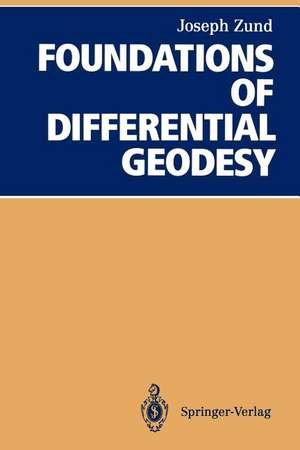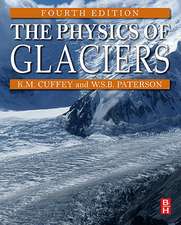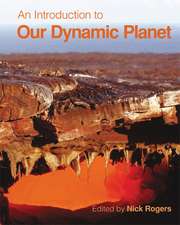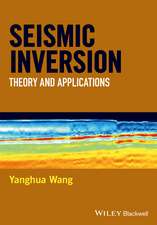Foundations of Differential Geodesy
Autor Joseph Zunden Limba Engleză Paperback – 12 dec 2011
The principal features of the Marussi-Hotine approach to theoretical aspects are given in the first five chapters (based on leg calculus), while the last five chapters are devoted to the fundamental ideas of the Marussi and Hotine theory. The text includes practical problems and is intended for use by research geodesists, graduate students in geodesy, and theoretical geophysicists.
Preț: 645.14 lei
Preț vechi: 758.99 lei
-15% Nou
Puncte Express: 968
Preț estimativ în valută:
123.46€ • 134.06$ • 103.71£
123.46€ • 134.06$ • 103.71£
Carte tipărită la comandă
Livrare economică 22 aprilie-06 mai
Preluare comenzi: 021 569.72.76
Specificații
ISBN-13: 9783642791895
ISBN-10: 3642791891
Pagini: 392
Ilustrații: XVI, 373 p.
Dimensiuni: 155 x 235 x 21 mm
Greutate: 0.55 kg
Ediția:Softcover reprint of the original 1st ed. 1994
Editura: Springer Berlin, Heidelberg
Colecția Springer
Locul publicării:Berlin, Heidelberg, Germany
ISBN-10: 3642791891
Pagini: 392
Ilustrații: XVI, 373 p.
Dimensiuni: 155 x 235 x 21 mm
Greutate: 0.55 kg
Ediția:Softcover reprint of the original 1st ed. 1994
Editura: Springer Berlin, Heidelberg
Colecția Springer
Locul publicării:Berlin, Heidelberg, Germany
Public țintă
ResearchDescriere
Differential geodesy is concerned with the geometry of the gravity field of the Earth, which is of fundamental importance to both theoretical geodesy and geophysics. This monograph presents a unified treatment of the foundations of differential geodesy as proposed originally by Antonio Marussi and Martin Hotine in their work.
The principal features of the Marussi-Hotine approach to theoretical aspects are given in the first five chapters (based on leg calculus), while the last five chapters are devoted to the fundamental ideas of the Marussi and Hotine theory. The text includes practical problems and is intended for use by research geodesists, graduate students in geodesy, and theoretical geophysicists.
The principal features of the Marussi-Hotine approach to theoretical aspects are given in the first five chapters (based on leg calculus), while the last five chapters are devoted to the fundamental ideas of the Marussi and Hotine theory. The text includes practical problems and is intended for use by research geodesists, graduate students in geodesy, and theoretical geophysicists.
Cuprins
I. Role of Coordinates in Geodesy and Geometry.- 1. Coordinates in Geodesy and Geometry.- 2. Marussi-Hotine Approach to Geodesy.- 3. Classical Formulations of the Tensor Calculus.- 4. Abstract Notion of a Tensor.- 5. Preview of the Leg Calculus 39 Problems for Chapter I.- II. Ricci Calculus.- 1. Introduction.- 2. 3-Leg Algebra.- 3. Congruences.- 4. Geometry of Congruences.- 5. Ricci Coefficients.- 6. Calculation of Ricci Coefficients.- 7. Commutativity of Leg Derivatives.- 8. Lie Bracket.- 9. Jacobi and Schouten Identities.- 10. Interpretation of Ricci Coefficients.- 11. Miscellaneous Leg Representations.- 12. Lamé Equations 67 Problems for Chapter II.- III. Cartan Calculus.- 1. Introduction.- 2. Exterior Product.- 3. Exterior Differentiation.- 4. Basic Properties of the Exterior Product and Differentiation.- 5. Cartan’s Viewpoint.- 6. Structural Equations of Cart an.- 7. Commutators and Schouten Identities.- 8. Cartan Calculus and the Classical Tensor Calculus.- 9. Coordinates in the Cartan and Ricci Calculus.- 10. Conclusions and Summary 99 Problems for Chapter III.- IV. General Leg Calculus.- 1. Introduction.- 2. Fundamental Idea of the Leg Calculus.- 3. Identification of the Ricci Coefficients.- 4. Permutation Algorithm.- 5. Interpretation of the Leg Coefficients.- 6. Basic Equations in the Leg Calculus.- 7. Commutators and Lie Brackets.- 8. Laplacian of a Scalar Function.- 9. Lamé Equations and Identities.- 10. Coordinates in the Leg Calculus.- 11. Reconstruction Theorem and General Viewpoint.- Problems for Chapter IV.- V. Gaussian Differential Geometry.- 1. Introduction.- 2. The Framework of Gaussian Differential Geometry.- 3. Gauss Operator and First Basic Form.- 4. Second Basic Form.- 5. Third and Fourth Basic Forms.- 6. Congruence and Surface Eigenstructure Theorems.- 7. Two Digressions.- 8. Basic Equations of the Surface Leg Calculus.- 9. Frenet Equations.- 10. Meusnier and Bonnet Formulas.- 11. Geodesic Curvature and Torsion in an Arbitrary Direction, and Euler’s Formula.- 12. Euler’s Osculating Paraboloid and Dupin’s Indicatrix of Curvature.- 13. Triply-Orthogonal Systems and Dupin’s Theorem.- Problems for Chapter V.- VI. Basic Equations for Differential Geodesy.- 1. Introduction.- 2. Newtonian Gravitation and the Geopotential Field.- 3. Marussi Ansatz and the Hotine 3-Leg.- 4. Hotine Leg Calculus and N-Integrability Conditions.- 5. Marussi Tensor.- 6. Bruns Curvature Equation.- 7. Bruns Equation and Hotine’s Theorem.- 8. n-Integrability Conditions.- 9. The Hotine-Marussi Equations.- 10. 3-Dimensional Laplacian of Local Gravity.- 11. 2-Dimensional Laplacian of Local Gravity.- Problems for Chapter VI.- VII. The Fundamental Theorem of Differential Geodesy.- 1. Introduction.- 2. Basic Assumptions.- 3. The Fundamental Theorem of Differential Geodesy.- 4. Discussion.- 5. Extension Problem.- 6. Two Subsidiary Problems.- 7. The Congruence-Forming Property.- 8. The Surface-Forming Property.- 9. Conclusions.- Problems for Chapter VII.- VIII. Algebraic Theory of the Marussi Tensor.- 1. Introduction.- 2. Eigenstructure of Symmetric Tensors.- 3. Eigenstructure of the Marussi Tensor.- 4. The Singularity Condition.- 5. Conclusions 268 Problems for Chapter VIII.- IX. Conformal Differential Geodesy.- 1. Introduction.- 2. Fundamental Notions of Conformal Geometry.- 3. Conformal Structural Equations.- 4. Conformal Ricci Coefficients.- 5. Conformal Surface Theory.- 6. Conformal Curve Theory.- 7. Generalized Conformal Transformations.- 8. Conclusions 300 Problems for Chapter IX.- X. Coordinates in Differential Geodesy.- 1. Introduction.- 2. Marussi Hypothesis and Hotine Problem.- 3. Hotine’s Hierarchy of Local Coordinate Systems.- 4. The Marussi-Hotine Approach: A Critique.- 5. Generalized Marussi-Hotine Approach: A Proposal.- 6. Conclusion 338 Problems for Chapter X.













